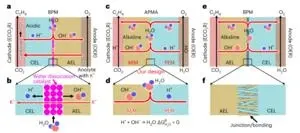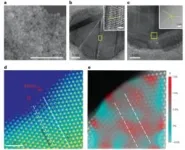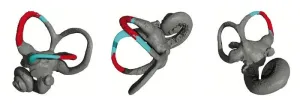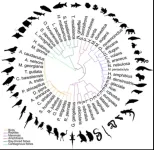(Press-News.org) A University of Houston optometry researcher is warning against the use of low-level red light (LLRL) therapy as a method to control myopia, or nearsightedness, especially in children. Over the last few years, LLRL has emerged as a viable myopia treatment after studies reported the treatment as effective and responsible for significant reduction in myopia progression. The company behind one of the devices reports that it is already being used to address myopia in over 100,000 pediatric patients.
But the excitement over its results as a myopia treatment may have come too soon, ahead of its proven safety.
"Based on measurements in our laboratory, it is recommended that clinicians strongly reconsider the use of LLRL therapy for myopia in children until safety standards can be confirmed,” report Lisa Ostrin, associate professor at the UH College of Optometry in The College of Optometrists journal.
Ostrin reports the therapy can put the retina at risk of photochemical and thermal damage. “The safety profiles of red-light laser devices for myopia have not been fully investigated,” she said.
For LLRL therapy, children are instructed to look into a red light-emitting instrument for three minutes, twice a day, five days a week, for the duration of the treatment period, which could last years.
“We found that the red-light instruments for myopia exceed safety limits,” said Ostrin, whose research characterizes the laser output and determines the thermal and photochemical maximum permissible exposure (MPE) of LLRL devices. “For both LLRL devices evaluated here, three minutes of continuous viewing approached or surpassed the luminance dose MPE, putting the retina at risk of photochemical damage.”
Ostrin examined two different LLRL devices, and while both instruments were confirmed to be Class-1 laser products, as defined by International Electrotechnical Commission standards, according to Ostrin they are unsafe to view continuously for the required treatment duration of three minutes.
Class-1 lasers are low-powered devices that are considered safe from all potential hazards when viewed accidentally and briefly. Examples of Class-1 lasers are laser printers, CD players and digital video disc (DVD) devices. Class-1 lasers are not meant to be viewed directly for extended periods.
“Thermal ocular injury from a laser can occur with exposures at any wavelength when the temperature change of the retina is greater than 10°C, resulting in the denaturation of proteins. With thermal damage, the lesion size is typically less than the size of the beam diameter, and the resultant scotomas are permanent.” said Ostrin.
END
University of Houston expert warns red light myopia therapy can injure retina
Popularity of myopia treatment may have come too soon
2024-01-29
ELSE PRESS RELEASES FROM THIS DATE:
Can science beat counterfeit detector pens? (video)
2024-01-29
WASHINGTON, Jan. 29, 2024 — Counterfeit detector pens use a starch-iodine reaction to identify fake bills. But could you fool them with chemistry? In today’s episode, we dive into the chemistry of iodine, its color and its clock reactions, all while making a little extra cash on the side. https://www.youtube.com/watch?v=xDaVCyOBSsY
Reactions is a video series produced by the American Chemical Society and PBS Digital Studios. Subscribe to Reactions at http://bit.ly/ACSReactions and follow us on Twitter @ACSReactions.
The American Chemical Society (ACS) is a nonprofit organization chartered by the U.S. Congress. ACS’ mission is to advance the broader ...
How did humans learn to walk? New evolutionary study offers an earful
2024-01-29
Humans and our closest relatives, living apes, display a remarkable diversity of types of locomotion—from walking upright on two legs to climbing in trees and walking using all four limbs.
While scientists have long been intrigued by the question of how humans’ bipedal stance and movement evolved from a quadrupedal ancestor, neither past studies nor fossil records have permitted the reconstruction of a clear and definitive history of the early evolutionary stages that led to human bipedalism.
However, a new study, which centers on recently discovered evidence from skulls of a 6-million-year-old fossil ape, Lufengpithecus, ...
Alzheimer’s disease acquired from historic medical treatments
2024-01-29
Five cases of Alzheimer’s disease are believed to have arisen as a result of medical treatments decades earlier, reports a team of UCL and UCLH researchers.
Alzheimer’s disease is caused by the amyloid-beta protein, and is usually a sporadic condition of late adult life, or more rarely an inherited condition that occurs due to a faulty gene. The new Nature Medicine paper provides the first evidence of Alzheimer’s disease in living people that appears to have been medically acquired and due to transmission of the amyloid-beta protein.
The people described in the paper had all been treated as ...
Food insecurity and premature mortality and life expectancy in the us
2024-01-29
About The Study: Although the association of food security and life expectancy varied across sex and racial and ethnic groups, overall, lower levels of food security were associated with a higher risk of premature mortality and a shorter life expectancy in this study of 57,000 adults. The findings of this study highlight the potential importance of improving food security in promoting population health and health equity.
Authors: Lu Qi, M.D., of Tulane University in New Orleans, is the corresponding author.
To access the embargoed ...
Wealth redistribution to extend longevity in the U.S.
2024-01-29
About The Study: The findings of this study of 35,000 adults age 50 or older suggest that wealth inequality in the U.S. is associated with significant inequities in survival. Wealth redistribution policies may substantially reduce those inequities and increase population longevity.
Authors: Kathryn E. W. Himmelstein, M.D., M.S.Ed., of Massachusetts General Hospital in Boston, is the corresponding author.
To access the embargoed study: Visit our For The Media website at this link https://media.jamanetwork.com/
(doi:10.1001/jamainternmed.2023.7975)
Editor’s Note: Please see the article for additional information, including other authors, author contributions and ...
Efficacy of electronic cigarettes vs varenicline and nicotine chewing gum as an aid to stop smoking
2024-01-29
About The Study: In this randomized clinical trial including 1,068 smokers, electronic cigarettes were as effective as varenicline and more effective than nicotine chewing gum as a stop-smoking aid when all three treatments were provided with minimal behavioral support.
Authors: Zhao Liu, Ph.D., of the China-Japan Friendship Hospital in Beijing, is the corresponding author.
To access the embargoed study: Visit our For The Media website at this link https://media.jamanetwork.com/
(doi:10.1001/jamainternmed.2023.7846)
Editor’s Note: Please see the article for additional information, ...
High school students who report using alcohol, cannabis or nicotine at higher risk for suicidal thoughts and other mental health disorders
2024-01-29
BOSTON –High school students who reported using cannabis, alcohol, or nicotine were more likely to have thoughts about suicide, feel depressed or anxious, have unusual experiences, and exhibit inattention or hyperactivity, according to recent survey-based study conducted by researchers at Massachusetts General Hospital (MGH) and the University of Minnesota.
The study, which is published in JAMA Pediatrics, included 2022–2023 survey results from more than 15,000 high school students across Massachusetts.
“We sought to determine ...
New evidence informs risk factors, diagnosis and care of patients with CVT stroke
2024-01-29
Embargoed until 4 a.m. CT/5 a.m. ET Monday, Jan. 29, 2024
DALLAS, January 29, 2024 — A new scientific statement from the American Heart Association emphasizes the need to increase patients’ and physicians’ awareness of cerebral venous thrombosis (CVT) to improve the recognition of this condition and initiate prompt medical treatment. The new statement, Diagnosis and Management of Cerebral Venous Thrombosis, published today in the American Heart Association/American Stroke Association’s peer-reviewed journal Stroke. ...
Researchers map genome for cats, dolphins, birds, and dozens of other animals
2024-01-29
Researchers mapped genetic blueprints for 51 species including cats, dolphins, kangaroos, penguins, sharks, and turtles, a discovery that deepens our understanding of evolution and the links between humans and animals.
“Being able to access that genetic information will have huge implications for understanding human health and evolution,” said lead author Michael Schatz, a Bloomberg Distinguished Professor of computer science and biology at Johns Hopkins University. “A lot of work ...
Overcoming the stigma: study recommends steps to move past barriers of brain health conversation
2024-01-29
INDIANAPOLIS -- Approximately four of five primary care clinicians consider themselves on the front lines of brain health. In the U.S., clinicians are the first point of contact for patients worried about memory loss and are most likely the first to detect and evaluate patients experiencing mild cognitive impairment, Alzheimer’s disease or related dementias.
In a new study focused on understanding the barriers of clinician-patient conversations about brain health and cognitive concerns, Regenstrief Institute and Indiana University School of Medicine Research Scientist Malaz Boustani, M.D., MPH, found that early conversations about brain health between ...
LAST 30 PRESS RELEASES:
Norbert Holtkamp appointed director of Fermi National Accelerator Laboratory
New agentic AI platform accelerates advanced optics design
Biologists discover neurons use physical signals — not electricity — to stabilize communication
Researchers discover that a hormone can access the brain by hitchhiking
University of Oklahoma researcher awarded funding to pursue AI-powered material design
Exploring how the visual system recovers following injury
Support for parents with infants at pediatric check-ups leads to better reading and math skills in elementary school
Kids’ behavioral health is a growing share of family health costs
Day & night: Cancer disrupts the brain’s natural rhythm
COVID-19 vaccination significantly reduces risk to pregnant women and baby
The role of vaccination in maternal and perinatal outcomes associated with COVID-19 in pregnancy
Mayo Clinic smartwatch system helps parents shorten and defuse children's severe tantrums early
Behavioral health spending spikes to 40% of all children’s health expenditures, nearly doubling in a decade
Digital cognitive behavioral treatment for generalized anxiety disorder
Expenditures for pediatric behavioral health care over time and estimated family financial burden
Air conditioning in nursing homes and mortality during extreme heat
The Alps to lose a record number of glaciers in the next decade
What makes a good proton conductor?
New science reporting guide published for journalists in Bulgaria
New international study reveals major survival gaps among children with cancer
New science reporting guide published for journalists in Turkey
Scientists develop a smarter mRNA therapy that knows which cells to target
Neuroanatomy-informed brain–machine hybrid intelligence for robust acoustic target detection
Eight SwRI hydrogen projects funded by ENERGYWERX
The Lundquist Institute and its start-up company Vitalex Biosciences Announces Strategic Advancement of Second-Generation fungal Vaccine VXV-01 through Phase 1 Trials under $40 Million Competitive Con
Fine particles in pollution are associated with early signs of autoimmune disease
Review article | Towards a Global Ground-Based Earth Observatory (GGBEO): Leveraging existing systems and networks
Penn and UMich create world’s smallest programmable, autonomous robots
Cleveland researchers launch first major study to address ‘hidden performance killer’ in athletes
To connect across politics, try saying what you oppose
[Press-News.org] University of Houston expert warns red light myopia therapy can injure retinaPopularity of myopia treatment may have come too soon





